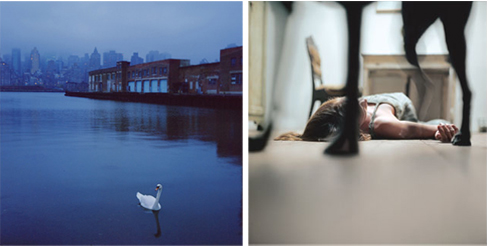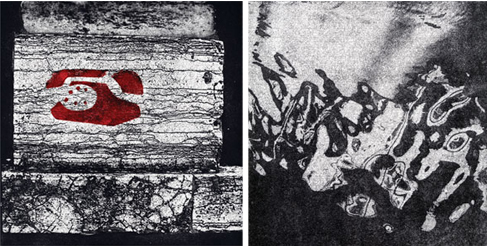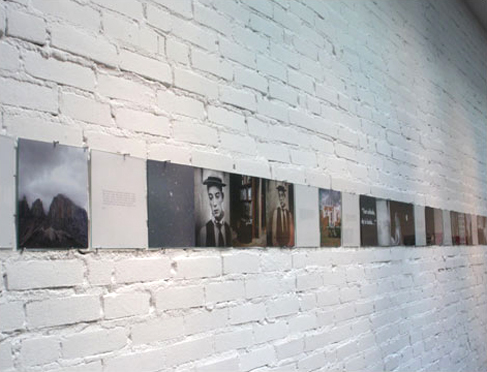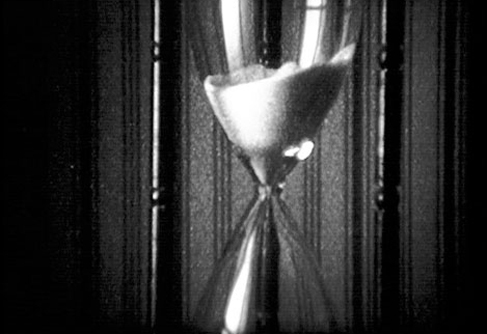|

SARA ROSSI
ORE DI VETRO
04.09 / 01.12 - 2009
The project, which combines Miele (book, 2005) and The Hourglass (video, 2003), began to take shape during Sara Rossi’s time in New York between 2002 and 2003 for the “Premio New York”. This is a scholarship granted by the Ministry of Foreign Affairs to attend Columbia University’s Italian Academy.
MIELE - text by Elisabetta Pozzetti
from “Acer Rubrum”, Miele - 2005
The thread worked by Sara’s hand encapsulates a sensitivity capable of drawing together delicate domestic microcosmos, precious memories of the past, shreds of stories and out of the ordinary encounters. Her journey was within New York. A New York that she has documented, internalising the lights, colours, smells and touch of it. A New York sensed too in its barriers. In its forbidden aspects. In its tragic contrasts. A metropolis loved and rejected. Fiercely desired, harshly abandoned. A small brown Bakelite suitcase lies in a corner. Like that of Duchamp, curator of a mobile museum. Or of Joseph Cornell brimming with memories. Or even, and here the triangle is complete, Walter Benjamin’s black case, which mysteriously disappeared after his death in the Pyrenees. It is therefore no coincidence that Sara has chosen to entrust her diary to this silent custodian, which visibly also doubles as a suitcase. She holds it in her hands, smiling, and confides that it nurtures a slab of material and life experiences. From over the ocean. Time to depart.
MIELE - text by Sara Rossi
from “Maple Syrup”, Miele - 2005
The city lies on the other side of the river, blue grey, as seen from my window. I can just make out Marcovaldo’s skullcap on my neighbour’s terrace and all is well, or so it seems.
Travelling is tiring because there is so much to learn. We learned the sadness of a knowledge that is vague, hallucinatory, as yet unformed, as we move from one thing to another. From up here life seems to flow smoothly, but I also feel disoriented, distant. New York is the most frequently photographed city in the world and as we gaze upon it, we recognise in each street corner, in each gutter, a costant déjà vù in the gaze of passers by lost in other stories. A carrousel of tragic masks submerged in a circle of vapour with flute players that never head anywhere. It is always party time, whatever the hour.
THE HOURGLASS - text by Sara Rossi
from “Maple Syrup”, Miele - 2005
R.’s house is long and narrow, with windows at either end. In the centre a little room has been created between the kitchen and the living room. Two doors and two alcoves are cut into the plasterboard walls, and in the hole facing the second room a bookcase has been created. A curtain hides it from the outside. This white cubicle is entirely sealed off on the inside and with its artificial lighting it provided the perfect setting for the film I wanted to make. I can’t say whether I made the film for the room or whether I slept in the room in the order to be able to make the film. I remember the sound of a large and very noisy alarm clock. It constituted a single, superfluous, fluctuating object within the silent empty space of the room. And so “The Hourglass” was born.
I thought of the hourglass that I broke shortly before leaving. I missed it. It would have been perfect and when I chanced upon one in the shop below, I realised that I could just shoot everything as it was. Now I could implement the project that I had in my mind – a black and white film about the passing of time, inspired by silent film and adapted to the situation, consisting in an imprecise image with the kind of roughness that I had come to love in Jonas Mekas’ style after seeing a couple of his films.
THE HOURGLASS - text by Jonathan Dronsfield
from “Short stories of videoart: 1965 - present”, Miele - 2005
This is one of those pieces that brings the otherwise useful distinction – that modern art is made to be looked at and contemporary art to be interacted with – in to question. What one is looking at here is the age of the world as picture. Not only did man once measure the world according to the belief that could place before himself image of the world as object but he did so as a subject able to capture time! The advent of the moving image both confirmed and undermined this conviction. This image barely moves. Sara Rossi has foregrounded the grain of the image at the expense of detail, the better to feel time passing slowly, very slowly. It results in a kind of static, or a hovering. But we can see when time has run its course, when the grain of sand no longer fall. Yet the grain of the image persists. This is a durational work, one in which time is experienced materially, in which time is the material of the work. Rossi’s addition to the genre of such works consists in allowing the duration of the piece to be determined not by the material of the medium but by the image of time made material. Warhol’s films ran out when the film stock did, Nauman’s tapes when the tape ran out, Baldessari’s tapes lasted as long as the range of possibilities of an action, Snow’s and Steina’s moving image pieces lasted as long as it took for a camera machine or a camera movement to exhaust its possibilities. All of these in one way of another involved repetition, the repetition of what is seen. Perhaps it is impossible to make durational works that do not repeat.
If so, repetition within “The Hourglass” is in the fall of the grains and in the shimmering of the grain in the image. But we also have the subtle repetition of the mechanical soundtrack. It sounds like the distant mechanism of an idea that has finally run its course.


Biography
Born 1970 in Milan (IT).
Lives and works in Italy.
Website: www.sararossi.net


On Screening:
The Hourglass (Super8 on dvd, 46', 2003)
Selected Films:
Faust (Friedrich Wilhelm Murnau 1926)
F for Fake (Orson Welles 1973)
Don Quijote de Orson Welles (Orson Welles / Jess Franco 1992)
---
Curated by Marco Nember.
Developed in collaboration with
the Italian Institute of Culture in
Amsterdam between May 2009
and September 2013.
|